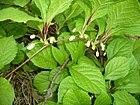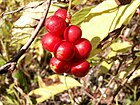Note: This is a project under development. The articles on this wiki are just being initiated and broadly incomplete. You can Help creating new pages.
Difference between revisions of "Schisandra chinensis - Five flavor berry"
Chaithrika (talk | contribs) m (Chaithrika moved page Five-flavor berry to Schisandra chinensis: renaming as per convention) |
(→List of Ayurvedic medicine in which the herb is used) |
||
| (10 intermediate revisions by 2 users not shown) | |||
| Line 1: | Line 1: | ||
[[File:Schisandra sinensis.jpg|thumb|right|''Schisandra chinensis'', ''Five-flavor berry'']] | [[File:Schisandra sinensis.jpg|thumb|right|''Schisandra chinensis'', ''Five-flavor berry'']] | ||
| − | Schisandra chinensis | + | '''Schisandra chinensis''' is a deciduous woody vine and it is native to forests of Northern China and the Russian Far East. The species itself is dioecious, thus flowers on a female plant will only produce fruit when fertilized with pollen from a male plant. |
| − | == | + | ==Uses== |
| − | + | {{Uses|Liver disease}}, {{Uses|High cholesterol}}, {{Uses|Pneumonia}}, {{Uses|Cough}}, {{Uses|Asthma}}, {{Uses|Sleep problems}}, {{Uses|Tiredness}}, {{Uses|Neurasthenia}}, {{Uses|Chronic diarrhea}}, {{Uses|Depression}}, {{Uses|Memory loss}}. | |
| − | |||
| − | == | + | ==Parts Used== |
| + | {{Parts Used|Fruits}}, {{Parts Used|Leaves}}. | ||
| − | + | ==Chemical Composition== | |
| − | + | Deoxyschizandrin, γ-schizandrin, wuweizisu C, gomisin N, schizandrin, anwuweizic acid, dihydroguaiaretic acid, tetradecanoic acid, β-sitosterol and daucosterol<ref name="chemical composition"/> | |
| − | + | ||
| − | + | ==Common names== | |
| + | {{Common names|kn=|ml=|sa=|ta=|te=|hi=|en=Five flavor berry}} | ||
| + | |||
| + | ==Properties== | ||
| + | Reference: Dravya - Substance, Rasa - Taste, Guna - Qualities, Veerya - Potency, Vipaka - Post-digesion effect, Karma - Pharmacological activity, Prabhava - Therepeutics. | ||
| + | ===Dravya=== | ||
| + | |||
| + | ===Rasa=== | ||
| + | Tikta (Bitter), Kashaya (Astringent) | ||
| + | ===Guna=== | ||
| + | Laghu (Light), Ruksha (Dry), Tikshna (Sharp) | ||
| + | ===Veerya=== | ||
| + | Ushna (Hot) | ||
| + | ===Vipaka=== | ||
| + | Katu (Pungent) | ||
| + | ===Karma=== | ||
| + | Kapha, Vata | ||
| + | ===Prabhava=== | ||
| + | |||
| + | ==Habit== | ||
| + | {{Habit|Herb}} | ||
| + | |||
| + | ==Identification== | ||
| + | ===Leaf=== | ||
| + | {{Leaf|Simple||The leaves are divided into 3-6 toothed leaflets, with smaller leaflets in between}} | ||
| + | |||
| + | ===Flower=== | ||
| + | {{Flower|Unisexual|2-4cm long|Yellow|5-20|Flowers Season is June - August}} | ||
| + | |||
| + | ===Fruit=== | ||
| + | {{Fruit||7–10 mm (0.28–0.4 in.) long pome|clearly grooved lengthwise, Lowest hooked hairs aligned towards crown|With hooked hairs|}} | ||
| + | |||
| + | ===Other features=== | ||
| + | |||
| + | ==List of Ayurvedic medicine in which the herb is used== | ||
| + | |||
| + | ==Where to get the saplings== | ||
| + | ==Mode of Propagation== | ||
| + | {{Propagation|Seeds}}. | ||
| + | |||
| + | ==How to plant/cultivate== | ||
| + | Prefers a rich well-drained moisture retentive soil<ref name="How to plant/cultivate"/> | ||
| + | |||
| + | ==Commonly seen growing in areas== | ||
| + | {{Commonly seen|shade with moist}}, {{Commonly seen|well-drained soil}}, {{Commonly seen|Borders of forests and fields}}. | ||
| + | |||
| + | ==Photo Gallery== | ||
| + | <gallery class="left" caption="" widths="140px" heights="140px"> | ||
| + | File:Schisandra chinensis a.JPG|Sakhalin, Russia | ||
| + | File:Schisandra chinensis b.JPG|Sakhalin, Russia | ||
| + | File:Schisandra chinensis c.JPG|Sakhalin, Russia | ||
| + | File:Schisandra chinensis d.JPG|Sakhalin, Russia | ||
| + | File:Schisandra chinensis e.JPG|Sakhalin, Russia | ||
| + | </gallery> | ||
| + | |||
| + | ==References== | ||
| + | |||
| + | <references> | ||
| + | <ref name="chemical composition">[https://www.ncbi.nlm.nih.gov/pubmed/25895389 "chemical constituents"]</ref> | ||
| + | |||
| + | <ref name="How to plant/cultivate">[https://www.pfaf.org/user/plant.aspx?latinname=Schisandra+chinensis "Cultivation details"]</ref> | ||
| + | </references> | ||
| + | |||
| + | ==External Links== | ||
| + | * [https://www.sciencedirect.com/science/article/pii/S1756464613001473 Schisandra chinensis on science dorect] | ||
| + | * [https://www.mdidea.com/products/herbextract/schisandra/data05.html Schisandra chinensis-Phytochemicals and Constituents of Schisandra Fruit ] | ||
| + | * [https://thenaturopathicherbalist.com/herbs/r-s/schisandra-chinensis/ Schisandra chinensis on the naturopathic herbalist.information] | ||
| + | * [http://www.nutragreenbio.com/product/schisandra-chinensis-extract Schisandra chinensis on nutragreen bio informrtion] | ||
| − | |||
| − | |||
| − | |||
[[Category:Herbs]] | [[Category:Herbs]] | ||
| + | [[Category:Schisandraceae]] | ||
Latest revision as of 09:46, 13 June 2019
Schisandra chinensis is a deciduous woody vine and it is native to forests of Northern China and the Russian Far East. The species itself is dioecious, thus flowers on a female plant will only produce fruit when fertilized with pollen from a male plant.
Contents
- 1 Uses
- 2 Parts Used
- 3 Chemical Composition
- 4 Common names
- 5 Properties
- 6 Habit
- 7 Identification
- 8 List of Ayurvedic medicine in which the herb is used
- 9 Where to get the saplings
- 10 Mode of Propagation
- 11 How to plant/cultivate
- 12 Commonly seen growing in areas
- 13 Photo Gallery
- 14 References
- 15 External Links
Uses
Liver disease, High cholesterol, Pneumonia, Cough, Asthma, Sleep problems, Tiredness, Neurasthenia, Chronic diarrhea, Depression, Memory loss.
Parts Used
Chemical Composition
Deoxyschizandrin, γ-schizandrin, wuweizisu C, gomisin N, schizandrin, anwuweizic acid, dihydroguaiaretic acid, tetradecanoic acid, β-sitosterol and daucosterol[1]
Common names
| Language | Common name |
|---|---|
| Kannada | |
| Hindi | |
| Malayalam | |
| Tamil | |
| Telugu | |
| Marathi | NA |
| Gujarathi | NA |
| Punjabi | NA |
| Kashmiri | NA |
| Sanskrit | |
| English | Five flavor berry |
Properties
Reference: Dravya - Substance, Rasa - Taste, Guna - Qualities, Veerya - Potency, Vipaka - Post-digesion effect, Karma - Pharmacological activity, Prabhava - Therepeutics.
Dravya
Rasa
Tikta (Bitter), Kashaya (Astringent)
Guna
Laghu (Light), Ruksha (Dry), Tikshna (Sharp)
Veerya
Ushna (Hot)
Vipaka
Katu (Pungent)
Karma
Kapha, Vata
Prabhava
Habit
Identification
Leaf
| Kind | Shape | Feature |
|---|---|---|
| Simple | The leaves are divided into 3-6 toothed leaflets, with smaller leaflets in between |
Flower
| Type | Size | Color and composition | Stamen | More information |
|---|---|---|---|---|
| Unisexual | 2-4cm long | Yellow | 5-20 | Flowers Season is June - August |
Fruit
| Type | Size | Mass | Appearance | Seeds | More information |
|---|---|---|---|---|---|
| 7–10 mm (0.28–0.4 in.) long pome | clearly grooved lengthwise, Lowest hooked hairs aligned towards crown | With hooked hairs | {{{6}}} |
Other features
List of Ayurvedic medicine in which the herb is used
Where to get the saplings
Mode of Propagation
How to plant/cultivate
Prefers a rich well-drained moisture retentive soil[2]
Commonly seen growing in areas
shade with moist, well-drained soil, Borders of forests and fields.
Photo Gallery
References
External Links
- Ayurvedic Herbs known to be helpful to treat Liver disease
- Ayurvedic Herbs known to be helpful to treat High cholesterol
- Ayurvedic Herbs known to be helpful to treat Pneumonia
- Ayurvedic Herbs known to be helpful to treat Cough
- Ayurvedic Herbs known to be helpful to treat Asthma
- Ayurvedic Herbs known to be helpful to treat Sleep problems
- Ayurvedic Herbs known to be helpful to treat Tiredness
- Ayurvedic Herbs known to be helpful to treat Neurasthenia
- Ayurvedic Herbs known to be helpful to treat Chronic diarrhea
- Ayurvedic Herbs known to be helpful to treat Depression
- Ayurvedic Herbs known to be helpful to treat Memory loss
- Herbs with Fruits used in medicine
- Herbs with Leaves used in medicine
- Herbs with common name in English
- Habit - Herb
- Index of Plants which can be propagated by Seeds
- Herbs that are commonly seen in the region of shade with moist
- Herbs that are commonly seen in the region of well-drained soil
- Herbs that are commonly seen in the region of Borders of forests and fields
- Herbs
- Schisandraceae





